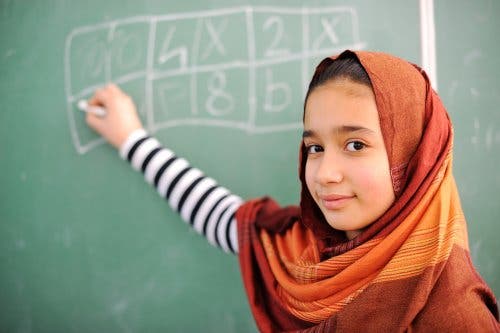Intercultural Education in the Classroom


Written and verified by the social educator Natalia Cobos Serrano
It’s a fact that modern classrooms are more diverse and multicultural than before. Because of this, teachers need to know how to adapt the teaching-learning process through intercultural education in the classroom.
“Intercultural education is not and should not be educating children belonging to ethnic minorities. It should teach all children to live and collaborate within a multicultural society.”
– Antonio Muñoz –
What is intercultural education?
Unlike multiculturalism, this term doesn’t only refer to different cultures living together. The term intercultural also implies communication. In addition, it advocates and supports interaction, coexistence and exchange among different cultural groups.
According to the Commission of the European Communities, intercultural education is a set of educational practices. Additionally, they all promote mutual respect and understanding among all students. This is regardless of their cultural, linguistic, ethnic and religious background.

We know that culture is dynamic. In other words, it constantly changes. So, we need to know how to define and approach intercultural education.
It stresses that cultural differences are the norm. It also explains that all schools have people from different cultures.
Intercultural education in the classroom is necessary
In addition to the unstoppable phenomenon of cultural globalization, our societies become more and more diverse every day. With this in mind, we need to adapt to this new situation. We also need to see what’s happening in our schools and act accordingly.
The researcher Jesús Viñas says that intercultural education shouldn’t just be used in places that are very diverse. Every school needs it.
The goal of intercultural education isn’t to just help kids get along at school. On the one hand, it’s to show them how to respect cultural diversity. On the other hand, it’s to show them that cultural differences make us better and stronger.
How to implement it in classrooms
Intercultural education means we have to change our mindset. In order to bring this into the classroom, we have to rethink and redefine what happens at school. Then, we have to adapt it to the demands of the multicultural classroom. We need a plan that includes actions and projects based on recognition, respect and social cohesion.

When talking about cultural exchange, we are also talking about respecting cultural identity. Intercultural education teaches that cultural diversity makes us all better. So, we should respect and value other people’s cultures.
Professor Julia Porras shares key values:
- Value and respect differences.
- Understand that differences are an inherent and enriching part of human nature.
- Peaceful conflict resolution.
- Empathy.
- Teamwork and shared goals.
Finally, at schools, we need to teach kids and teens to respect cultural diversity, and how this benefits all of us. In fact, this type of education teaches future adults about social justice. Teach your students that coexistence and dialogue are the way to achieve respectful societies.
It’s a fact that modern classrooms are more diverse and multicultural than before. Because of this, teachers need to know how to adapt the teaching-learning process through intercultural education in the classroom.
“Intercultural education is not and should not be educating children belonging to ethnic minorities. It should teach all children to live and collaborate within a multicultural society.”
– Antonio Muñoz –
What is intercultural education?
Unlike multiculturalism, this term doesn’t only refer to different cultures living together. The term intercultural also implies communication. In addition, it advocates and supports interaction, coexistence and exchange among different cultural groups.
According to the Commission of the European Communities, intercultural education is a set of educational practices. Additionally, they all promote mutual respect and understanding among all students. This is regardless of their cultural, linguistic, ethnic and religious background.

We know that culture is dynamic. In other words, it constantly changes. So, we need to know how to define and approach intercultural education.
It stresses that cultural differences are the norm. It also explains that all schools have people from different cultures.
Intercultural education in the classroom is necessary
In addition to the unstoppable phenomenon of cultural globalization, our societies become more and more diverse every day. With this in mind, we need to adapt to this new situation. We also need to see what’s happening in our schools and act accordingly.
The researcher Jesús Viñas says that intercultural education shouldn’t just be used in places that are very diverse. Every school needs it.
The goal of intercultural education isn’t to just help kids get along at school. On the one hand, it’s to show them how to respect cultural diversity. On the other hand, it’s to show them that cultural differences make us better and stronger.
How to implement it in classrooms
Intercultural education means we have to change our mindset. In order to bring this into the classroom, we have to rethink and redefine what happens at school. Then, we have to adapt it to the demands of the multicultural classroom. We need a plan that includes actions and projects based on recognition, respect and social cohesion.

When talking about cultural exchange, we are also talking about respecting cultural identity. Intercultural education teaches that cultural diversity makes us all better. So, we should respect and value other people’s cultures.
Professor Julia Porras shares key values:
- Value and respect differences.
- Understand that differences are an inherent and enriching part of human nature.
- Peaceful conflict resolution.
- Empathy.
- Teamwork and shared goals.
Finally, at schools, we need to teach kids and teens to respect cultural diversity, and how this benefits all of us. In fact, this type of education teaches future adults about social justice. Teach your students that coexistence and dialogue are the way to achieve respectful societies.
All cited sources were thoroughly reviewed by our team to ensure their quality, reliability, currency, and validity. The bibliography of this article was considered reliable and of academic or scientific accuracy.
- Essoma, M.A. (1999). Construir la escuela intercultural. Graò. Biblioteca de Aula. España.
- Porras, J. (2010). El valor de la educación intercultural. Visión Libros. España: Madrid.
This text is provided for informational purposes only and does not replace consultation with a professional. If in doubt, consult your specialist.








